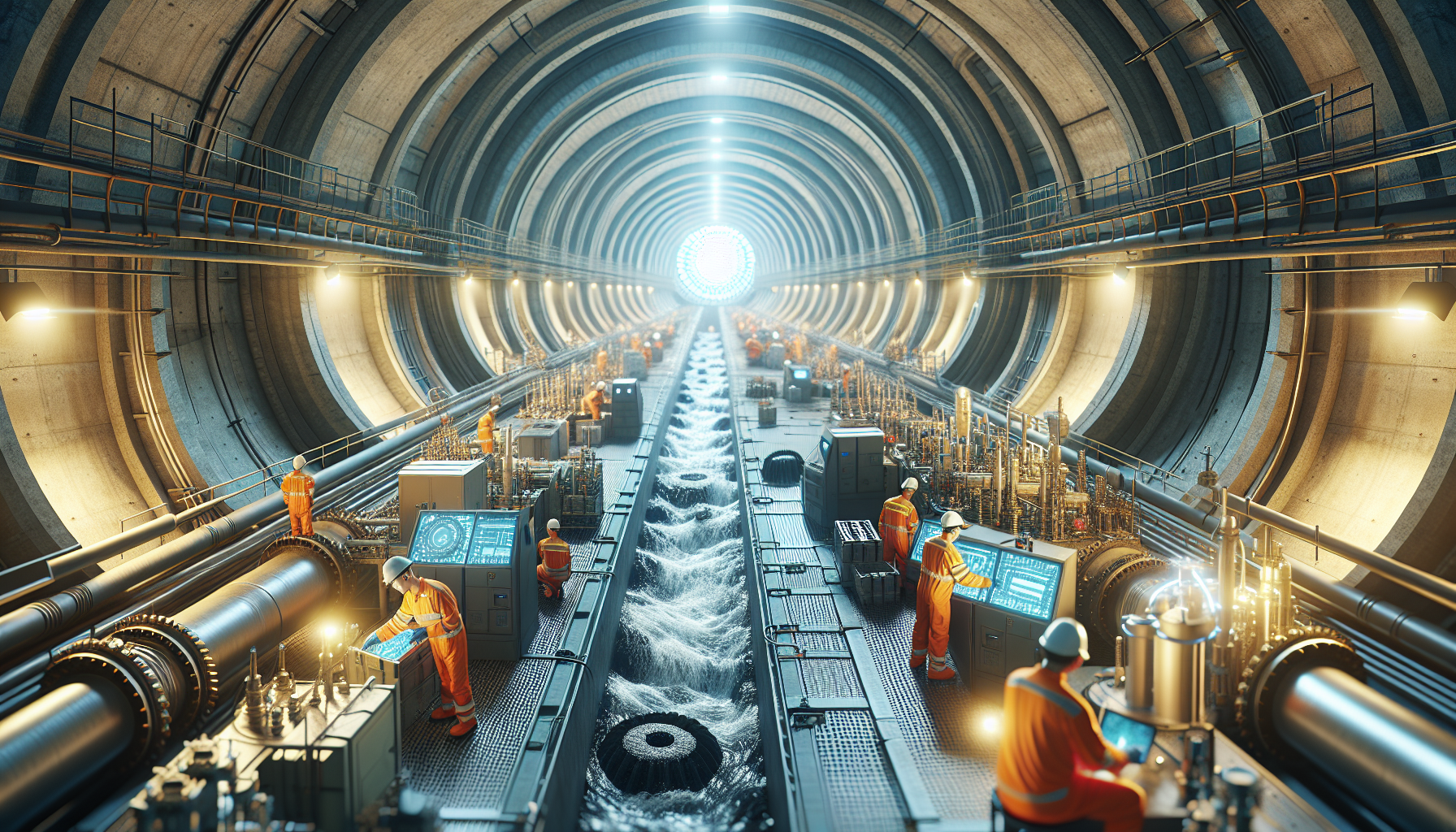In the bustling heart of modern cities, beneath the rhythmic hum of everyday life, lies a hidden world that is quietly revolutionizing how we manage one of humanity’s oldest challenges: waste. Welcome to the innovative realm of modern sewage tunnels—a marvel of engineering and sustainability that holds the potential to transform urban living. As cities continue to expand and populations surge, the pressure on traditional waste management systems intensifies. This has led to the emergence of cutting-edge sewage tunnel technologies that promise not only to improve the efficiency of waste disposal but also to redefine our relationship with the environment. 🌍
At first glance, the concept of sewage might not evoke images of innovation and sophistication. Yet, delve a little deeper, and you’ll discover an intricate network of underground pathways designed with precision and purpose. These modern marvels of civil engineering are not just conduits for waste; they are dynamic systems equipped with advanced technologies aimed at optimizing the flow and treatment of wastewater. From the integration of smart sensors that monitor waste levels and flow rates in real-time to the use of sustainable materials that ensure durability and reduce environmental impact, the evolution of sewage tunnels is nothing short of remarkable. In this article, we will explore the intricate design and functionality of these tunnels, highlighting the breakthroughs that are setting new standards in waste management.
But why does this matter to us? The importance of revolutionizing waste management extends far beyond infrastructure—it touches on public health, environmental conservation, and urban sustainability. As we navigate the complexities of modern living, the quest for sustainable solutions becomes imperative. Through this exploration, we aim to unravel the complexities of sewage tunnels, spotlighting the innovations that are not only safeguarding our environment but also paving the way for smarter cities. Join us as we venture into this subterranean frontier, where technology meets nature in the most unexpected ways, and discover how the reimagining of sewage systems is offering a cleaner, greener future for generations to come. 🌟
The Evolution of Sewage Systems: From Ancient Methods to Modern Tunnels
The development of sewage systems has been integral to urbanization, public health, and environmental protection. Historically, ancient civilizations such as the Indus Valley and Roman Empire pioneered basic sewage systems to manage waste and prevent disease outbreaks. These systems, although rudimentary, laid the groundwork for modern sewage management. The Roman Cloaca Maxima, one of the world’s earliest sewage systems, exemplifies how ancient infrastructure was not only functional but also durable, some of it still in use today. Fast forward to the 19th century, the industrial revolution prompted the rapid growth of urban areas, necessitating more advanced sewage systems to cope with increased waste production.
The technological advancements of the 20th century transformed sewage management from open drains and cesspools to comprehensive sewer networks. Innovations in engineering and materials science allowed the construction of vast underground tunnel systems that efficiently transported waste away from urban centers to treatment facilities. These developments marked a significant shift towards the modern sewage tunnels we see today, which are characterized by their efficiency, sustainability, and technological integration.
In recent decades, the focus has shifted towards sustainability and minimizing environmental impact. Modern sewage tunnels are designed not only to transport waste but also to incorporate water recycling and energy recovery processes. The integration of sensors and automation technologies has enhanced monitoring and maintenance, ensuring the systems operate at optimal efficiency. This evolution reflects a broader trend towards smart infrastructure, where technology plays a pivotal role in managing urban services. To dive deeper into this evolution, check out this informative video: “The History of Sewage Systems” by Engineering World.
Technological Innovations in Modern Sewage Tunnels
Modern sewage tunnels have seen a remarkable transformation thanks to technological innovations. These advancements have revolutionized how we handle waste, making processes more efficient, sustainable, and less intrusive to urban life. One of the most significant innovations is the use of Tunnel Boring Machines (TBMs), which have drastically reduced the time and labor required to construct underground tunnels. These machines, often equipped with advanced sensors and navigation systems, can bore through various soil types with minimal disruption to the surrounding environment.
Moreover, the implementation of real-time monitoring systems has greatly enhanced the operational efficiency of sewage tunnels. Sensors installed throughout these networks collect data on flow rates, blockages, and structural integrity, allowing for predictive maintenance and quick response to any issues. This integration of IoT (Internet of Things) technology ensures that sewage systems are not only more reliable but also more adaptive to changing conditions, such as heavy rainfall or increased urban waste production.
Additionally, many modern sewage tunnels are now being designed with sustainability in mind. This includes the incorporation of systems that recover heat and energy from waste, as well as those that treat and recycle water for non-potable uses. Such features not only reduce the environmental footprint of sewage systems but also provide economic benefits by lowering operational costs and generating renewable energy. The table below compares traditional sewage systems with modern innovations:
| Feature | Traditional Sewage Systems | Modern Sewage Tunnels |
|---|---|---|
| Construction Method | Open trenches, manual labor | Tunnel Boring Machines, automated systems |
| Monitoring | Manual inspections | Real-time sensor networks |
| Sustainability | Minimal focus | Energy recovery, water recycling |
The Environmental Impact and Benefits of Advanced Sewage Tunnels
The impact of advanced sewage tunnels on the environment is profound, as they are designed to mitigate pollution and promote ecological sustainability. One of the primary benefits is the reduction of untreated waste entering natural water bodies, which significantly decreases water pollution. By efficiently transporting sewage to treatment facilities, these tunnels help protect aquatic ecosystems and improve water quality, ensuring a healthier environment for both wildlife and humans.
Furthermore, modern sewage tunnels are often equipped with facilities for biogas production, a renewable energy source generated from organic waste decomposition. This not only provides a sustainable energy solution but also reduces greenhouse gas emissions associated with traditional waste management practices. By converting waste into energy, these systems contribute to a circular economy, where resources are reused and recycled, minimizing environmental impact.
Another environmental benefit is the reduction in surface disruption. Traditional sewage systems often required extensive excavation and construction, which could be disruptive to urban landscapes and ecosystems. In contrast, tunnel boring technology allows for deep underground construction with minimal surface impact, preserving green spaces and reducing the ecological footprint of infrastructure projects. For more insights into how these tunnels benefit the environment, watch the video “Sustainable Sewage Solutions” on the EcoTech channel.
How You Can Support Sustainable Sewage Management
As individuals, there are several ways we can contribute to the sustainability of sewage systems. Simple actions such as reducing water usage, properly disposing of waste, and supporting infrastructure projects that prioritize sustainability can make a significant difference. Additionally, staying informed and advocating for policies that promote sustainable waste management is crucial in driving systemic change. Here’s how you can take action:
- Reduce water consumption by fixing leaks and using water-saving fixtures.
- Dispose of waste properly by avoiding flushing non-biodegradable items.
- Support initiatives and policies that invest in sustainable infrastructure.

Conclusion
Conclusion: Revolutionizing Waste Management: Inside the Innovative World of Modern Sewage Tunnels
As we journeyed through the expansive topic of modern sewage tunnels, it becomes clear that these systems are not merely functional infrastructures but are at the forefront of technological and environmental innovation. The critical points explored in this article highlight the multifaceted impact of these tunnels on urban planning, environmental sustainability, and public health.
Firstly, we delved into the historical evolution of sewage systems, tracing how advancements in technology and engineering have transformed rudimentary waste disposal methods into sophisticated networks that efficiently manage urban waste. This historical context set the stage for understanding the revolutionary changes in modern sewage tunnels, characterized by state-of-the-art design and functionality.
In discussing the design and construction of these tunnels, we recognized the role of cutting-edge technology and materials that enhance durability and efficiency. Innovations such as automated monitoring systems and advanced filtration techniques not only improve the operational efficacy of sewage tunnels but also ensure that they meet stringent environmental standards. These developments are vital as they contribute to reducing the ecological footprint of urban areas and minimizing the risk of pollution.
Moreover, the integration of smart technology in sewage management was a significant focus. Smart sensors and IoT devices enable real-time monitoring and data collection, providing valuable insights into the functioning of sewage systems. This technology allows for proactive maintenance and management, preventing potential failures and optimizing the flow of waste. Such innovations represent a critical shift towards sustainable urban living, where cities can effectively manage their resources while minimizing environmental impact.
We also explored the socio-economic implications of modern sewage tunnels. Beyond their environmental benefits, these infrastructures play a crucial role in supporting public health by preventing the outbreak of waterborne diseases and ensuring the sanitary disposal of waste. Additionally, the construction and maintenance of sewage tunnels create job opportunities, contributing to local economies and fostering community development.
The environmental impact of these systems cannot be overstated. By significantly reducing pollution levels and improving the quality of water bodies, modern sewage tunnels support biodiversity and promote a healthier ecosystem. This aligns with global efforts to combat climate change and protect natural resources for future generations.
In reinforcing the importance of modern sewage tunnels, it is essential to recognize their role as catalysts for change. They exemplify how innovative thinking and technological advancements can address pressing global challenges, such as urban waste management and environmental degradation. As cities continue to grow and face increasing waste management demands, these tunnels offer a sustainable and scalable solution.
The significance of this topic extends beyond the realm of engineering and urban planning. It touches the lives of individuals by providing cleaner, healthier environments and ensuring the sustainable use of resources. The successful implementation of these systems depends on collaboration between governments, private sectors, and communities, highlighting the importance of collective effort in addressing complex issues.
In conclusion, the innovative world of modern sewage tunnels is a testament to human ingenuity and resilience. As we strive for sustainable development and environmental preservation, these infrastructures represent a beacon of hope and progress. They remind us of the transformative power of innovation and the endless possibilities it holds for creating a better future.
We encourage you, dear reader, to engage with this topic further. Consider how modern sewage systems affect your community and explore opportunities to advocate for and support sustainable waste management practices. Share this article with others who might benefit from this knowledge and join the conversation on how we can collectively contribute to a cleaner, healthier world 🌍.
For further reading and resources, explore these reliable sources:
1. World Health Organization: Water, Sanitation, and Hygiene
2. Environmental Protection Agency: Waste Management
Together, let’s inspire change and contribute to the revolutionary advancements in waste management. Thank you for being part of this important journey.
Toni Santos is a visual storyteller and artisan whose work explores the quiet power of what lies beneath. With a deep fascination for subterranean and hidden architecture, Toni uncovers the layers, voids, and forgotten spaces that shape our built environment from the shadows.
His art is a journey through the unseen — from ancient underground chambers to sealed passageways, service tunnels, and foundations buried in time. Each creation tells a story of silence, secrecy, and structure — revealing how absence and concealment can be just as meaningful as what’s visible above ground.
Whether working through visual compositions, architectural studies, or symbolic handcrafted pieces, Toni captures the soul of hidden spaces. His work bridges art and archaeology, blending design with discovery. Trained in visual design and traditional techniques, Toni creates with intention. His pieces don’t just depict — they interpret, inviting viewers to rethink what space, memory, and architecture mean when they’re hidden from view.
As the creative force behind Vizevex, Toni shares this perspective through curated visual narratives, symbolic collections, and interpretive essays that give voice to the quiet geometries beneath our feet.
His work is a tribute to:
The mystery of spaces built to be forgotten
The symbolism embedded in foundations, voids, and passageways
The timeless connection between human intention and hidden structure
Whether you’re an artist, an urban explorer, or someone fascinated by the unseen frameworks that support our world, Toni invites you into a realm where architecture becomes myth — one corridor, one layer, one buried story at a time.





